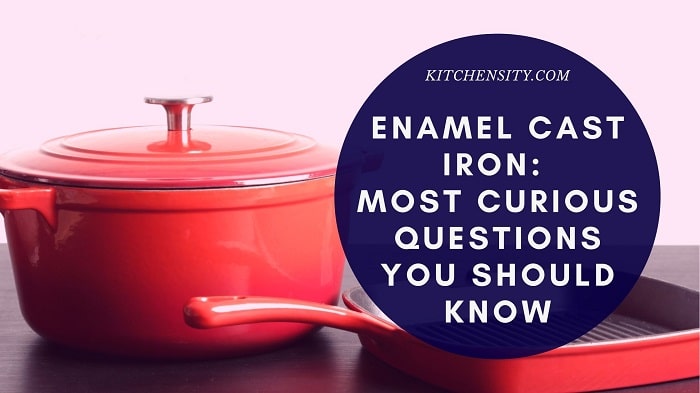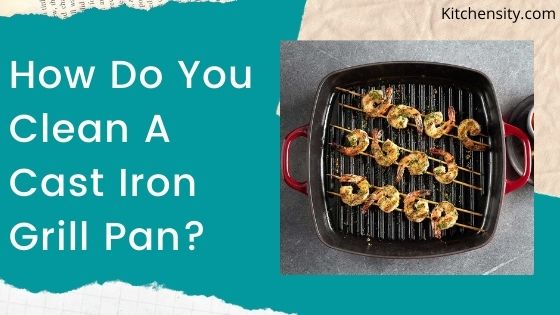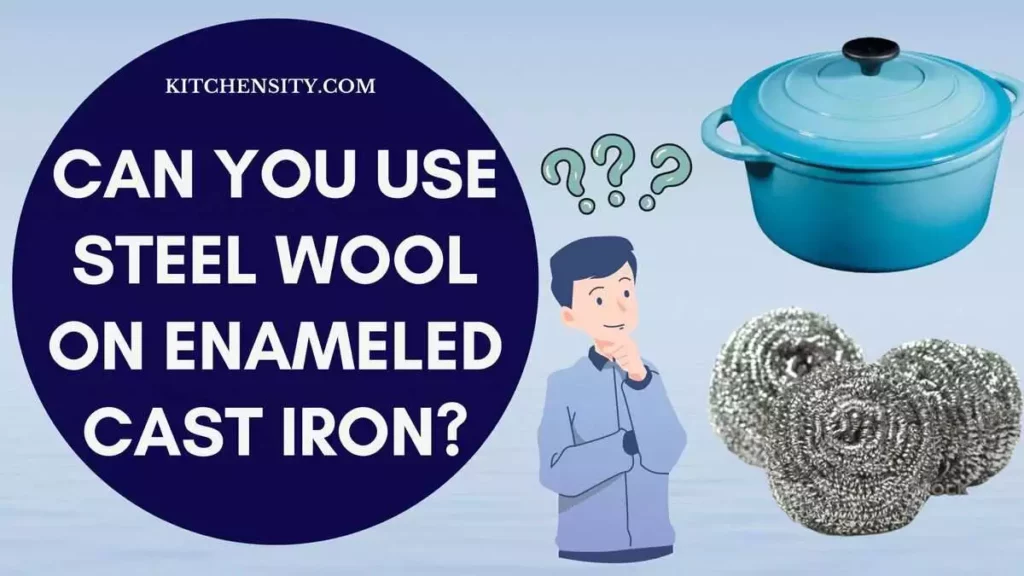Discovering rust on your cast iron skillet can be disheartening, but fear not—there’s a straightforward solution using a kitchen staple: baking soda.
In this guide, we’ll walk you through the steps to clean a rusty cast iron skillet with baking soda, a method that not only removes rust efficiently but also preserves the simplicity and eco-friendliness of everyday kitchen essentials.
Let’s embark on a journey to restore your cast iron skillet to its former glory, making it ready for many more delicious meals.
Table of Contents
- 1 How To Clean A Rusty Cast Iron Skillet With Baking Soda?
- 2 Causes Of Rust On Cast Iron Skillets
- 3 Why Baking Soda Is Effective In Cleaning Rust Cast Iron?
- 4 Fastest Way To Remove Rust From Cast Iron
- 5 How To Remove Heavy Rust From Cast Iron?
- 6 Cleaning Cast Iron With Baking Soda And Vinegar
- 7 Is Rust On Cast Iron Dangerous?
- 8 What Do You Mix With Baking Soda To Remove Rust?
- 9 Does Vinegar And Baking Soda Get Rid Of Rust?
- 10 Alternative Methods To Clean Rusty Cast Iron Skillet
- 11 Common Mistakes To Avoid
- 11.1 1. Using Harsh Chemicals
- 11.2 2. Scrubbing Too Vigorously
- 11.3 3. Neglecting Safety Precautions
- 11.4 4. Skipping Pre-Cleaning Preparation
- 11.5 5. Neglecting Drying
- 11.6 6. Using Steel Wool Incorrectly
- 11.7 7. Ignoring Regular Maintenance
- 11.8 8. Storing Without Proper Care
- 11.9 9. Using Excessive Heat
- 11.10 10. Not Re-Seasoning After Cleaning
- 12 Tips For Preventing Rust On Cast Iron Skillet
- 13 Final Thoughts
- 14 FAQs: Clean A Rusty Cast Iron Skillet With Baking Soda
How To Clean A Rusty Cast Iron Skillet With Baking Soda?
To clean a rusty cast iron skillet with baking soda, create a paste using baking soda and water. Apply the paste to the rusted areas, let it sit for 15-20 minutes, then scrub with a brush or sponge. Rinse thoroughly, dry completely, and re-season the skillet for optimal results.
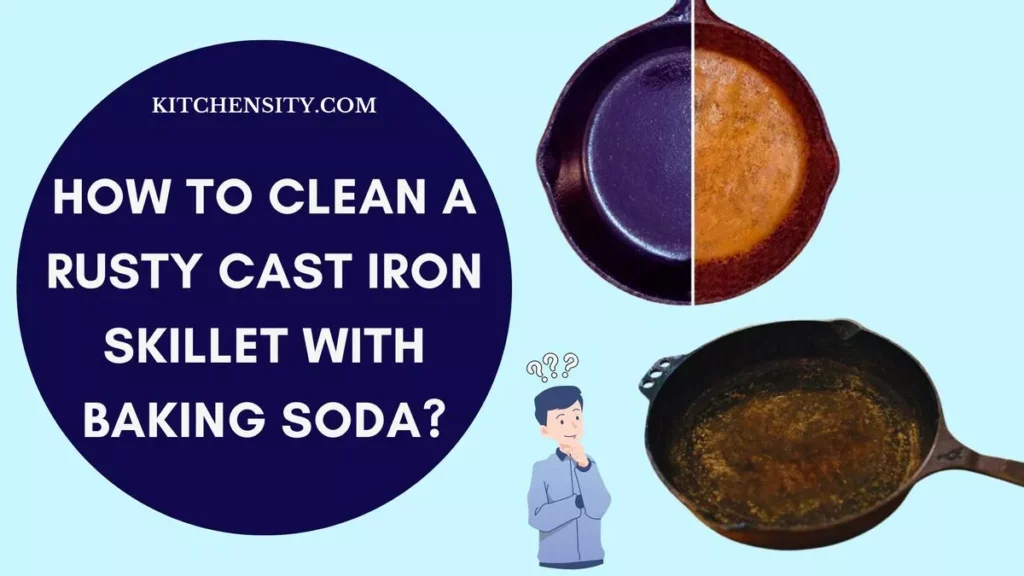
Follow these step-by-step instructions to restore your skillet to its former glory:
Materials Needed
- Baking soda
- Water
- Soft brush or sponge
- Vinegar (optional)
- Towel
Steps
- Assess The Rust: Examine the skillet to identify the areas affected by rust. Understanding the extent of rust will help determine the amount of baking soda needed.
- Create Baking Soda Paste: In a small bowl, mix baking soda with water to create a thick paste. The paste’s consistency should be suitable for spreading but not too runny.
- Apply Baking Soda Paste: Using a spoon or your fingers, apply the baking soda paste directly onto the rusted areas of the cast iron skillet. Ensure a generous coating on each rusty spot.
- Let It Sit: Allow the baking soda paste to sit on the rusted areas for at least 15-20 minutes. This gives the baking soda time to react with the rust and begin the cleaning process.
- Scrub Gently: Take a soft brush or sponge and gently scrub the rusted areas. The baking soda acts as a mild abrasive, aiding in the removal of rust without damaging the cast iron surface.
- Focus On Stubborn Spots: For more stubborn rust, you can intensify the cleaning process. Mix equal parts water and vinegar to create a solution and apply it to the rusted areas. Let it sit for a few minutes before scrubbing again.
- Rinse Thoroughly: Rinse the cast iron skillet under warm running water to remove the baking soda residue and loosened rust. Ensure that all baking soda is washed away.
- Inspect The Results: After rinsing, inspect the skillet to see if the rust has been successfully removed. If needed, repeat the process for any remaining rust spots.
- Dry Immediately: Thoroughly dry the cast iron skillet using a towel. Prevent any moisture from remaining on the surface, as this can lead to new rust formation.
- Re-Season The Skillet: After cleaning, it’s crucial to re-season the cast iron skillet. Apply a thin layer of oil (preferably with a high smoke point, like vegetable oil) to the entire skillet, including the areas that were rusted. Bake the skillet upside down in a preheated oven for about an hour.
- Store Properly: Store the cast iron skillet in a cool, dry place. Consider placing a paper towel or cloth between the skillet and its lid to absorb any potential moisture during storage.
Also Read – is it safe to cook in a rusty cast iron pan?
Causes Of Rust On Cast Iron Skillets
Rust on cast iron skillets can be a common challenge, but understanding the causes is crucial for effective prevention and maintenance. Let’s delve into the various factors that contribute to the formation of rust on these beloved kitchen tools.
- Moisture Exposure: Cast iron is highly susceptible to rust when exposed to moisture. If a skillet is not thoroughly dried after use or is stored in a damp environment, water can accumulate on its surface, initiating the rusting process.
- Lack Of Proper Drying: Inadequate drying after washing is a primary cause of rust. Even a small amount of residual moisture left on the skillet’s surface can lead to oxidation, resulting in the formation of rust over time.
- Absence Of Seasoning: Seasoning is a crucial protective layer on cast iron skillets. When this layer is compromised or absent, the iron is exposed to air and moisture, making it susceptible to rust. Regularly seasoning your skillet helps maintain its integrity.
- Highly Acidic Foods: Cooking highly acidic foods, such as tomatoes or vinegar-based dishes, in a cast iron skillet can contribute to rust. The acid can react with the iron, accelerating the oxidation process and promoting rust formation.
- Improper Storage: Storing cast iron skillets in a location prone to humidity or drastic temperature changes can exacerbate rust issues. Proper storage in a cool, dry place is essential to prevent moisture accumulation.
- Long-Term Neglect: Neglecting your cast iron skillet for extended periods without proper cleaning and seasoning allows rust to take hold. Regular use and maintenance are key to preventing the onset of rust.
- Abrasive Cleaning Techniques: Using abrasive cleaning tools, like steel wool or harsh brushes, can strip away the protective seasoning and expose the iron surface. This makes the skillet more susceptible to rust over time.
Also Read – Why Do Cast Iron Pans Crack?
What Are The Consequences Of Neglecting Rust On Cookware?
Neglecting rust on cookware, especially on materials like cast iron, can have several undesirable consequences. Let’s explore the potential issues that arise when rust is left unaddressed:
- Altered Flavor Of Food: Rust on cookware can impart a metallic taste to your food. This alteration in flavor can negatively impact the overall dining experience, making dishes less appetizing.
- Compromised Aesthetics: Rust creates unsightly stains and discoloration on cookware. Neglecting these visual issues not only diminishes the aesthetic appeal of your kitchen tools but can also affect your perception of the cleanliness of the cooking surface.
- Weakened Structural Integrity: Over time, rust can weaken the structural integrity of the cookware. This compromises its durability and longevity, leading to potential breakage or failure during cooking.
- Health Concerns: Consuming food cooked on rusted surfaces may pose health risks. Iron oxides from rust can leach into food, especially in acidic dishes, potentially causing health issues when ingested over an extended period.
- Reduced Cooking Performance: Rust impedes the natural non-stick properties of well-maintained cookware. Food may start to stick to the surface, making cooking more challenging and resulting in unevenly cooked dishes.
- Increased Cleaning Difficulty: As rust accumulates, the cookware becomes more challenging to clean. Stubborn rust spots may require intensive scrubbing, leading to potential damage to the surface or the removal of seasoning, exacerbating the problem.
- Spread Of Rust: Neglected rust tends to spread. What starts as a small patch can grow over time, affecting larger areas of the cookware. Addressing rust promptly is crucial to prevent its escalation.
- Unpleasant Odor: Rust can contribute to an unpleasant odor in both the cookware and the food prepared in it. This odor can be transferred to the kitchen environment, affecting the overall ambiance.
- Diminished Cooking Experience: Cooking with rusted cookware can be frustrating and less enjoyable. It may discourage you from using certain pans or utensils, limiting your culinary options.
- Risk Of Contamination: Rusted cookware may harbor bacteria in the crevices and pores created by oxidation. This poses a risk of contamination, especially when rust is present in areas that come into direct contact with food.
Also Read – How To Season Cast Iron Grates On Gas Stove?
Why Baking Soda Is Effective In Cleaning Rust Cast Iron?
Baking soda is a highly effective and popular choice for cleaning rust on cast iron due to its unique properties and gentle abrasive nature. Let’s delve into why baking soda stands out as a powerful agent in restoring the luster of your rusty cast iron skillet:
- Mild Abrasive Action: Baking soda’s fine particles act as a gentle abrasive. This property makes it effective in scrubbing away rust without causing damage to the surface of the cast iron. The abrasiveness is sufficient to lift rust particles but mild enough to preserve the skillet’s seasoning.
- Neutral Ph: Baking soda is known for its neutral pH, which means it is neither acidic nor alkaline. This neutrality makes it a safe option for cleaning without compromising the composition of the cast iron or reacting with the rust in a way that could further damage the skillet.
- Non-Toxic And Environmentally Friendly: Baking soda is a safe, non-toxic substance, making it an eco-friendly option for cleaning. Unlike some chemical rust removers, baking soda poses no health risks and does not release harmful fumes during use.
- Readily Available And Inexpensive: Baking soda is a common household item found in most kitchens. Its accessibility and low cost make it a convenient choice for rust removal, eliminating the need for specialized and potentially expensive cleaning products.
- Versatility In Applications: Baking soda can be used in various forms, such as a dry powder or a paste mixed with water. This versatility allows you to customize its application based on the severity of rust and the condition of your cast iron skillet.
- Odor Absorption: Baking soda has the added benefit of absorbing and neutralizing odors. When used on a rusty cast iron skillet, it helps eliminate any unpleasant smells that may have developed as a result of oxidation.
- Minimal Impact On Seasoning: Seasoning is crucial for maintaining the non-stick properties of a cast iron skillet. Baking soda’s mild abrasiveness ensures that it cleans away rust without excessively removing the protective layer of seasoning, preserving the skillet’s seasoned surface.
- Compatibility With Other Cleaning Agents: Baking soda can be easily combined with other household items, such as vinegar, to create a powerful yet safe cleaning solution. This combination enhances the rust-removing properties of baking soda without introducing harmful chemicals.
Also Read – Learn To Re-Enamel Le Creuset Cookware
Fastest Way To Remove Rust From Cast Iron
The fastest way to remove rust from cast iron is by using a 1:1 mixture of white vinegar and water. Soak the rusty areas in the solution for a few hours, then scrub with a brush or sponge. Finish by thoroughly drying and re-seasoning the cast iron skillet.
- To quickly remove rust from cast iron, create a solution by mixing equal parts white vinegar and water. Submerge the rusted areas of the skillet in this solution for a few hours, allowing the acidic properties of the vinegar to break down and loosen the rust.
- After soaking, use a brush or sponge to scrub away the loosened rust. The acidity of the vinegar aids in the rust removal process. Ensure thorough scrubbing, paying attention to stubborn rust spots.
- Once the rust is removed, rinse the cast iron skillet under warm water to eliminate any remaining vinegar residue. Promptly dry the skillet thoroughly to prevent new rust from forming.
- To complete the process, re-season the cast iron skillet by applying a thin layer of oil and baking it upside down in a preheated oven. This not only restores the skillet’s protective layer but also enhances its non-stick properties.
Also Read – Restore A Cast Iron Griddle Like A Pro
How To Remove Heavy Rust From Cast Iron?
Removing heavy rust from cast iron requires a more intensive approach. Here’s a step-by-step guide:
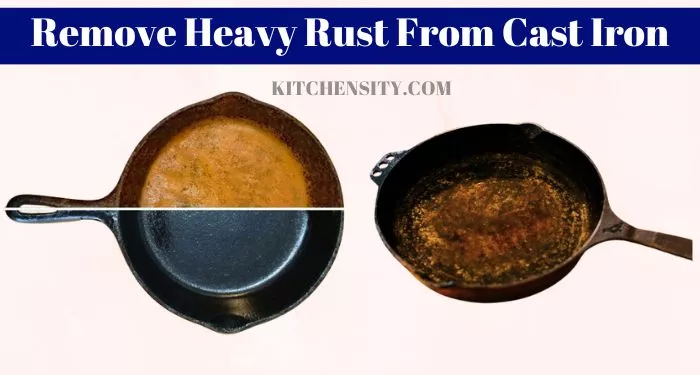
Materials Needed
- White vinegar
- Baking soda
- Steel wool or scrub brush
- Water
- Towel
- Vegetable oil
- Oven
Also Read – Hacks To Clean A Cast Iron BBQ Griddle
Steps
- Assessment: Examine the cast iron skillet to identify the extent of heavy rust. Determine if any areas are severely affected.
- Vinegar Soak: Submerge the entire skillet or the rusted parts in a solution of equal parts white vinegar and water. Let it soak for several hours or overnight. The vinegar’s acidity will work to dissolve the rust.
- Scrub With Steel Wool: After soaking, use steel wool or a scrub brush to vigorously scrub the rusted areas. Apply pressure to remove the rust, and keep scrubbing until the surface starts to feel smoother.
- Baking Soda Paste: Create a paste using baking soda and water. Apply the paste to the remaining rust spots and scrub again. Baking soda acts as a gentle abrasive to help remove stubborn rust.
- Rinse Thoroughly: Rinse the skillet under running water to remove vinegar and baking soda residue. Inspect the skillet to see if all heavy rust has been eliminated.
- Dry Completely: Thoroughly dry the cast iron skillet with a towel. Ensure no moisture remains on the surface to prevent new rust from forming.
- Inspect And Repeat If Necessary: Inspect the skillet to check for any remaining heavy rust. If needed, repeat the vinegar soak and scrubbing process until the rust is fully removed.
- Re-Season The Skillet: Once the heavy rust is removed, re-season the cast iron skillet. Apply a thin layer of vegetable oil to the entire skillet, including the cleaned areas. Bake the skillet upside down in a preheated oven for an hour to restore its protective seasoning.
Also Read – Why Is Cast Iron Pan Sticky After Seasoning?
Cleaning Cast Iron With Baking Soda And Vinegar
Cleaning cast iron with a combination of baking soda and vinegar is effective. The process involves creating a paste with baking soda and water, applying it to the rusted areas, and then using a vinegar solution to enhance the cleaning. This combination leverages the mild abrasiveness of baking soda and the acidic properties of vinegar to break down rust, making it easier to scrub away. After cleaning, thorough rinsing and proper drying are essential, followed by re-seasoning to maintain the cast iron’s protective layer.
Is Rust On Cast Iron Dangerous?
Rust on cast iron itself is not inherently dangerous. It’s a common occurrence due to the nature of iron reacting with moisture and oxygen in the air. However, there are considerations to keep in mind:
- Health Concerns: Consuming food cooked in a rusted cast iron skillet may introduce iron oxides into your diet. While small amounts are generally considered safe, excessive ingestion may lead to health issues. It’s crucial to address rust promptly and maintain proper seasoning to minimize the risk.
- Taste And Appearance: Rust can alter the taste of food cooked in a cast iron skillet, imparting a metallic flavor. Additionally, it affects the appearance of dishes, making them less appetizing.
- Structural Integrity: Over time, if rust is left unattended, it can compromise the structural integrity of the cast iron. Severe rusting may lead to pitting or even holes in the skillet, rendering it less effective for cooking.
While rust itself is not dangerous, addressing it promptly is essential to maintain the quality and safety of your cast iron cookware. Regular cleaning, seasoning, and proper care can prevent rust from becoming a significant issue.
Also Read – Seasoned Vs Unseasoned Cast Iron Skillet
What Do You Mix With Baking Soda To Remove Rust?
To remove rust using baking soda, you can mix it with water to create a paste. The baking soda and water combination forms a mild abrasive that aids in scrubbing away rust from surfaces. This paste is effective in breaking down rust without causing damage to the underlying material, making it a popular and non-toxic solution for rust removal.
Does Vinegar And Baking Soda Get Rid Of Rust?
Yes, vinegar and baking soda, when used together, can be effective in getting rid of rust. The combination of these two common household items creates a chemical reaction that helps dissolve rust. The acidic vinegar reacts with the baking soda, producing carbon dioxide and forming a solution that can break down and loosen rust. This makes it easier to scrub away the rust from surfaces, leaving them cleaner. Keep in mind that for heavy rust or severe cases, multiple applications or additional methods may be needed.
Also Read – Best Enameled Cast Iron Cookware Sets
Alternative Methods To Clean Rusty Cast Iron Skillet
While baking soda is a highly effective method for cleaning a rusty cast iron skillet, alternative approaches are using readily available household items. Here are two alternative methods that can help restore your cast iron skillet to its former glory:
1. Salt And Potato Method
Materials Needed
- Coarse salt
- Potato (cut in half)
Steps
- Sprinkle Salt On Rusty Areas: Generously sprinkle coarse salt directly onto the rusted portions of the cast iron skillet.
- Use Potato As A Scrubber: Take the cut side of the potato and use it as a natural scrubbing pad. The oxalic acid in the potato, combined with the abrasive salt, helps lift and remove rust without damaging the skillet’s surface.
- Scrub Thoroughly: Scrub the rusted areas with the potato, applying gentle pressure. Continue until you see improvement in the rust removal.
- Rinse And Dry: Once the rust has been lifted, rinse the skillet with water and thoroughly dry it to prevent new rust from forming.
Also Read – Is Your Enameled Cast Iron Cookware Safe?
2. Lemon And Salt Technique
Materials Needed
- Lemon (cut in half)
- Table salt
Steps
- Apply Salt To Rusty Areas: Sprinkle a layer of table salt onto the rusted portions of the cast iron skillet.
- Use Lemon As A Scrubber: Take one-half of the lemon and use it as a natural scrubber. The acidity of the lemon, combined with the abrasive salt, works to dissolve and lift the rust.
- Scrub Gently: Gently scrub the rusted areas with the lemon, ensuring the salt is in contact with the rust. Continue until you observe the rust diminishing.
- Rinse And Dry: Rinse the skillet with water to remove any lemon or salt residue, and then thoroughly dry it to prevent new rust formation.
Both the salt and potato method and the lemon and salt technique are effective alternatives to cleaning rust on your cast iron skillet. These methods are natural, cost-efficient, and utilize items commonly found in your kitchen, offering you practical solutions for maintaining the health and longevity of your cookware.
Also Read – Pros And Cons Of Using Olive Oil To Season Cast Iron Pans
Common Mistakes To Avoid
When it comes to cleaning a rusty cast iron skillet, certain common mistakes should be avoided to ensure the effectiveness of the cleaning process and the preservation of the skillet’s integrity. Here are key mistakes to steer clear of:
1. Using Harsh Chemicals
- Mistake: Applying strong chemical rust removers or abrasive cleaners.
- Why to Avoid: Harsh chemicals can damage the seasoning of the cast iron and even pose health risks if not thoroughly rinsed. Opt for gentler, natural alternatives like baking soda or vinegar.
2. Scrubbing Too Vigorously
- Mistake: Scrubbing the skillet with excessive force or using abrasive tools.
- Why to Avoid: Overly aggressive scrubbing can remove not only rust but also the skillet’s seasoning, leaving it vulnerable to future rusting. Use a gentle touch to preserve the protective layer.
3. Neglecting Safety Precautions
- Mistake: Failing to use safety gear when necessary.
- Why to Avoid: Some cleaning agents, like vinegar, may require proper ventilation and the use of gloves. Neglecting safety precautions can lead to skin irritation or respiratory issues.
4. Skipping Pre-Cleaning Preparation
- Mistake: Not preparing the skillet adequately before cleaning.
- Why to Avoid: Skipping steps like removing excess food particles or ensuring proper ventilation can hinder the cleaning process. Preparing the skillet beforehand ensures better results.
5. Neglecting Drying
- Mistake: Not drying the skillet thoroughly after cleaning.
- Why to Avoid: Leaving the skillet damp promotes new rust formation. Thorough drying is crucial to maintaining a rust-free surface.
6. Using Steel Wool Incorrectly
- Mistake: Using coarse steel wool or scrubbing excessively with steel wool.
- Why to Avoid: While fine-grade steel wool can be used, coarse steel wool may scratch the surface of the cast iron. Additionally, excessive scrubbing can compromise the skillet’s seasoning.
7. Ignoring Regular Maintenance
- Mistake: Neglecting routine cleaning and seasoning.
- Why to Avoid: Regular maintenance is essential for preventing rust. Ignoring this aspect can lead to more severe rusting issues over time.
8. Storing Without Proper Care
- Mistake: Storing the cast iron skillet in a humid or damp environment.
- Why to Avoid: Improper storage can contribute to rust formation. Store the skillet in a cool, dry place to prevent moisture accumulation.
9. Using Excessive Heat
- Mistake: Subjecting the skillet to extreme temperatures.
- Why to Avoid: Extreme heat can cause thermal shock, potentially damaging the skillet. Gradual heating and cooling are recommended.
10. Not Re-Seasoning After Cleaning
- Mistake: Neglecting to re-season the skillet after cleaning.
- Why to Avoid: Re-seasoning is crucial for rebuilding the protective layer on the cast iron. Skipping this step leaves the skillet vulnerable to rust.
Also Read – Season Or Not To Season? The Ultimate Enamel Cast Iron Dilemma Solved
Tips For Preventing Rust On Cast Iron Skillet
- Proper Drying: Thoroughly dry the skillet with a towel after cleaning to remove moisture.
- Immediate Seasoning: Apply a thin layer of oil and season the skillet immediately after each use.
- Store In A Dry Place: Store the skillet in a cool, dry place to avoid moisture exposure.
- Use High Smoke Point Oils: Choose oils with high smoke points, like vegetable or flaxseed oil, for seasoning.
- Regular Use: Regularly use the skillet to build up its seasoning and protection.
- Avoid Highly Acidic Foods: Limit cooking highly acidic foods to prevent rust acceleration.
- Avoid Dish Soap: If using soap, use a minimal amount and follow up with proper drying and seasoning.
- Gentle Cleaning Techniques: Use soft brushes or sponges to avoid stripping away the seasoning.
- Avoid Extreme Temperatures: Gradual heating and cooling prevent thermal shock and potential damage.
- Re-Season Regularly: Periodically re-season the skillet, especially if signs of wear or rust appear.
- Use A Lid: Place a paper towel or cloth between the lid and skillet when storing to absorb moisture.
- Avoid Cooking High-Water Content Foods: Transfer leftovers of high-water content foods to different containers.
- Inspect For Rust Regularly: Routinely check for signs of rust to catch it early and prevent spreading.
- Avoid Cooking Salty Foods Initially: Initially, avoid cooking extremely salty foods to preserve the seasoning.
- Use The Right Cooking Utensils: Choose utensils made of materials that won’t scratch or damage the skillet’s surface, like wooden or silicone utensils.
Also Read – Can You Put Enamel Cast Iron In The Dishwasher?
Final Thoughts
Cleaning a rusty cast iron skillet with baking soda proves to be a reliable and eco-friendly solution. The mild abrasive nature of baking soda, combined with its easy availability, makes it an accessible method for rust removal. The addition of vinegar further enhances the cleaning process by creating a synergistic reaction that breaks down rust effectively.
This approach not only removes rust but also allows for a gentle restoration of the skillet’s surface without compromising its seasoning. The simplicity of the method, coupled with the minimal use of common household items, contributes to its practicality and convenience.
As a final verdict, cleaning a rusty cast iron skillet with baking soda is a recommended method for those seeking a natural, cost-effective, and efficient way to revitalize their cookware. Regular maintenance using this technique ensures that your cast iron skillet remains a durable and cherished kitchen companion for years to come.
Also Read – Can You Use Vinegar On Enameled Cast Iron?
FAQs: Clean A Rusty Cast Iron Skillet With Baking Soda
-
How Often Should I Clean My Cast Iron Skillet?
Regular cleaning after each use is ideal. However, a deep clean to remove rust should be performed when signs of corrosion appear.
-
Can I Use Soap To Clean A Cast Iron Skillet?
While traditional advice discourages soap, a minimal amount is acceptable for stubborn residues. Always follow up with thorough drying.
-
Is It Normal For My Cast Iron Skillet To Rust?
While some rust is common, consistent rusting indicates inadequate maintenance. Regular seasoning and proper storage can prevent this.
-
What Is The Best Oil For Seasoning A Cast Iron Skillet?
Opt for oils with high smoke points like vegetable or flaxseed oil for effective seasoning.
-
Can I Use Steel Wool To Remove Rust?
Yes, but choose a fine-grade steel wool to avoid damaging the skillet’s surface.
Katrina Smith is a seasoned expert with over 25 years of experience in all things related to cooking and the kitchen. As an avid cook and kitchen enthusiast, she is passionate about sharing her knowledge and expertise on cookware, kitchen appliances, kitchen tips, and kitchen staples.
Through her articles and reviews, Katrina aims to inspire and help others improve their cooking skills, experiment with different ingredients, and invest in quality cookware and appliances.

![How To Season And Clean Cast Iron Cookware? [4 Effective Ways] 4 How To Season And Clean Cast Iron Cookware](https://www.kitchensity.com/wp-content/uploads/2020/06/How-To-Season-And-Clean-Cast-Iron-Cookware.jpg)
